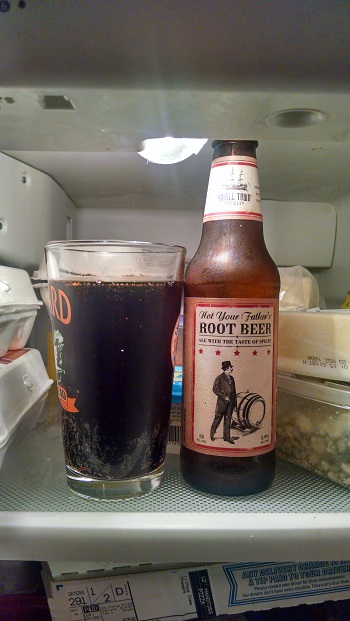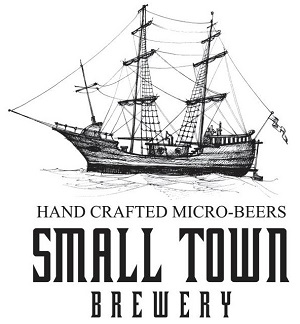Back To Their Roots
 Brewery
Brewery and
Country of Origin:
Small Town Brewery of
1000 North Rand Road #204, Wauconda, IL, 60084 USA
Date Reviewed: 7-24-15
Root beer, as it was originally conceived, was made with the roots of Sassafras (a deciduous tree) or Sarsaparilla (a vine), and used by Native Americans as traditional medicine and culinary elixirs. Europeans had been making sassafras brewed beverages similar to root beer since the 16th century. Root beer was, back then, actually beer. The beer typically involved cooking a sweet syrup made of molasses and water, cooling it, then adding the tree parts, (root, bark, wintergreen) for flavoring, and finally, yeast was then added in order for fermentation to take place. The beer would primary ferment for 12 hours, and then it would be strained and allowed to go through secondary fermentation in the bottle. Normal root beers were very light, often less than 2% ABV, but modifications could be made to produce more alcoholic beverages. Much like early
Farmhouse ales which arose from the need for potable drinking water during the hotter
Belgian harvest season, root beer was originally produced as a safer alternative than the often disease infested local sources of drinking water. The first successfully commercially marketed root beer was crafted by a pharmacist, Charles Elmer Hires, a Quaker from
Philadelphia in 1875. It was a sassafras-based tea like beverage which he called "root beer" in order to appeal to coal miners. It debuted at the Philadelphia Centennial Exposition in 1876, and in 1886, Hires began to bottle and distribute a beverage from the famous root based extract. By the 1890s, it was being widely distributed across all of the
United States. Non-alcoholic versions of the beer became very successful, especially during
prohibition. The rise in popularity of root beers in the early 1900s spurred competitors to enter the market, such as Barq's, IBC, and A&W, all of which are still around today. A&W is responsible for associating frosty mugs with root beer. Though the drink is widely popular in America still (being produced in every single state today), there is little awareness or production outside of the US (though some brands exist in Asia and Oceana). There is also no standard recipe, with many ingredients being used to vary typical commercial examples, such as vanilla (and the common practice of adding ice cream to make a root beer float), licorice root, anise, molasses, cinnamon, honey, tree bark, cherry, and nutmeg among others. This particular beer from
Small Town Brewery can pretty much be described as an alcoholic version of a non-alcoholic version of an alcoholic beverage. It is even brewed with vanilla and caramel color, much like many commercially available soft drinks are today. At least this time around, prohibition is long gone.
Date Sampled: 6-09-15 At: 7 Priscilla Road, Brighton, Boston, MA 02135, USA
Beer Style:
Herbed/Spiced Beer
Alcohol by Volume: 5.90%
Serving Type: 12 oz Bottle, 16 oz Tumbler Glass
Rating: 3.17
Look
This homage to the original root beers pours fairly choppy like with a medium high amount of carbonation action, producing a thin foam head with an half inch height, a very low retention rate, a tan color, and a low density. This beer has a clear and filtered appearance with a dark, dull brownish glow and a dark ruby red shine in bright light. This beer displays an above average amount of effervescent effect, no visible sediment, no settling, and no real amount of lacing on the glass either.
Aroma
This beer expectedly gives off a strong root beer-esque aroma full of sweet caramel and ginger root like aromas and spices. Overall, this is a sweet smelling beer with no detectable hoppy bitterness and only a small amount of alcoholic tinge, which is only noticeable when mentally or actually comparing this beer to real root beer. There is no metallic smell present, and the presence of additional vanilla extract gives this beer's aroma a somewhat root beer float like character. This aroma of this beer has a medium strength.
Feel
This is a medium bodied brew with an average weight, a below average viscosity, and a good amount of carbonation, all combined to make this a fairly crisp and somewhat refreshing beer which is good year round. This beer has a refreshing finish toward a dull, not dry close which also includes a subtle, but definitely noticeable alcohol bite. This beer has a pretty crisp feel throughout and is as easy to drink as it's non alcoholic inspiration. In fact, this beer's feel is very close to that of real root beer, save for the presence of noticeable alcohol.
Taste
As stated, like root beer, this actual beer is brewed with vanilla extract and caramel color, giving it the traditional sweet and earthy spicy flavors which make the soda a long time favorite of many. This beer tastes generally like root beer full of ginger, caramel, vanilla, and a hint of creamy flavor from the impression of vanilla ice cream. There are no fruity notes, no hoppy or bitter flavors, and a slight amount of alcohol taste toward an overall sweet and lingering aftertaste. This beer does have a hint of earthy/wood like tones and a small amount of biscuity notes present as well. This beer's small alcohol taste is it's biggest detractor, overemphasized by the beer's likeness to the real thing.
Our Take
We've tried many flavored beers before, some of which offer barely discernible hints of the beer's main selling point, while others may deliver strong flavors, but overall, beer will still taste like beer. This, however is different. We've tried beers brewed with
beans,
jalapeno peppers,
pumpkins, and even
live lobsters, but this is the first beer we've had that genuinely replicates an experience to a degree so great that it's hard to actually tell the two apart... after a few beers of course. That is partly because root beer, like actual beer, is indeed a liquid, unlike the other things typically brewed with beer. But mostly, this is pretty much going back to the original alcoholic root beers of centuries past, albeit more alcoholic this time around. As because this is so close to the soda it reminds us of, we couldn't help but notice the presence of alcohol, especially toward the end of the beverage, when the beer had been sitting out for a bit. While in most beers this isn't much of an issue, we found this to be particularly distracting in a beer which seemingly would make a perfect pair with vanilla ice cream (it actually probably would, but we didn't bother trying). This and the presence of alcohol in the aroma, were the biggest faults we found in this beer. Overall, however, this is a novelty beer which we found surprisingly pleasant, and, as we've said, impressively tastes like the real thing. Because this is a very sweet beer, we'd recommend this only as a pairing with desserts (especially cake, ice cream, and other sweet things) and Thin Mints Girl Scout Cookies.

 Not Your Father's Root Beer
Not Your Father's Root Beer



